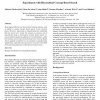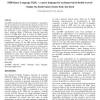MEDINFO
2007
14 years 26 days ago
2007
Medical language, as many technical languages, is rich with morphologically complex words, many of which take their roots in Greek and Latin—in which case they are called neocla...
MEDINFO
2007
14 years 26 days ago
2007
Ongoing concerns have been raised over the effectiveness of information technology products and systems in maintaining privacy protection for sensitive data. The aim is to ensure ...
MEDINFO
2007
14 years 26 days ago
2007
Many digital libraries use hierarchical indexing schema, such as MeSH to enable concept based search in the retrieval phase. However, improving or outperforming the traditional fu...
MEDINFO
2007
14 years 26 days ago
2007
Standardization of data is a prerequisite to achieve semantic interoperability in any domain. This is even more important in the healthcare sector where the need for exchanging he...
MEDINFO
2007
14 years 26 days ago
2007
OpenEHR specifications have been developed to standardise the representation of an international electronic health record (EHR). The language used for querying EHR data is not as ...
MEDINFO
2007
14 years 26 days ago
2007
Terminologies are increasingly based on “ontologies” developed in description logics and related languages such as the new Web Ontology Language, OWL. The use of description l...
MEDINFO
2007
14 years 26 days ago
2007
The accurate quantification of disease patterns in medical images allows radiologists to track the progress of a disease. Various computer vision techniques are able to automatica...
MEDINFO
2007
14 years 26 days ago
2007
This paper presents an idealized conceptual framework for consumer health informatics research drawing from complementary disciplines: information science and health campaign rese...
MEDINFO
2007
14 years 26 days ago
2007
In this paper we present the ongoing development and extension work on BioTop – a top-domain ontology for linking biomedical domain ontologies. We start by making the case for t...
MEDINFO
2007
14 years 26 days ago
2007
In this paper we describe a model of clinical information designed to make health information systems properly interoperable and safely computable. The model is a response to a nu...


